|
|
|
Sort Order |
|
|
|
Items / Page
|
|
|
|
|
|
|
| Srl | Item |
| 1 |
ID:
150027


|
|
|
|
|
| Summary/Abstract |
The demand for residential heat (RH) through a district heating system (DHS) has been and will be expanded in Korea due to its better performance in energy efficiency and the abatement of greenhouse gas emissions than decentralized boilers. The purposes of this paper are two-fold. The first is to obtain the demand function for DHS-based RH in Korea and investigate the price and income elasticities of the demand employing the quarterly data covering the period 1988–2013. The short-run price and income elasticities are estimated as −0.700 and 0.918, respectively. Moreover, the long-run elasticities are −1.253 and 1.642, respectively. The second purpose is to measure the consumption benefits of DHS-based-RH employing the economic theory that they are the sum of the actual payment and consumer surplus for the consumption. Considering that the average price and estimated consumer surplus of the DHS-based RH use in 2013 are computed to be KRW 87,870 (USD 84.1) and KRW 62,764 (USD 60.1) per Gcal, the consumption benefits of the DHS-based RH are calculated to be KRW 150,634 (USD 144.2) per Gcal. This information can be beneficially utilized to conduct an economic feasibility study for a new DHS project related to RH supply.
|
|
|
|
|
|
|
|
|
|
|
|
|
|
|
|
| 2 |
ID:
127902
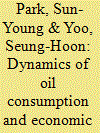

|
|
|
|
|
| Publication |
2014.
|
| Summary/Abstract |
This study attemps to investiagte the causal relationship between oil consumption and economic growth in Malaysia where oil consumption and real gross domestic product have been rapidly increased in recent years. To this end, the study employs annual data covering the period 1965-2011. Tests for unit roots, co-integration, and Granger-causality based on the error-correction models are presented. The overall results support the existence of bi-directional causality between oil consumption and economic growth in Malaysia. This means that an increase in oil consumption directly affect economic growth. Thus, in order not to make an adverse effect on economic growth, Malaysia should endeavor to overcome the constraints on oil consumption. Moreover, it appears that economic growth induces oil consumption
|
|
|
|
|
|
|
|
|
|
|
|
|
|
|
|
| 3 |
ID:
150395
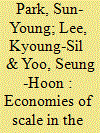

|
|
|
|
|
| Summary/Abstract |
This paper aims to investigate the cost efficiency of South Korea’s district heating (DH) system by using a variable cost function and cost-share equation. We employ a seemingly unrelated regression model, with quarterly time-series data from the Korea District Heating Corporation (KDHC)—a public utility that covers about 59% of the DH system market in South Korea—over the 1987–2011 period. The explanatory variables are price of labor, price of material, capital cost, and production level. The results indicate that economies of scale are present and statistically significant. Thus, expansion of its DH business would allow KDHC to obtain substantial economies of scale. According to our forecasts vis-à-vis scale economies, the KDHC will enjoy cost efficiency for some time yet. To ensure a socially efficient supply of DH, it is recommended that the KDHC expand its business proactively. With regard to informing policy or regulations, our empirical results could play a significant role in decision-making processes.
|
|
|
|
|
|
|
|
|
|
|
|
|
|
|
|
| 4 |
ID:
093536
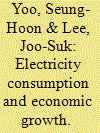

|
|
|
|
|
| Publication |
2010.
|
| Summary/Abstract |
Electricity has been the foundation of economic growth, and constitutes one of the vital infra-structural inputs in socio-economic development. The world faces a surge in demand for electricity that is driven by such powerful forces as population growth, extensive urbanization, industrialization, and the rise in the standard of living. This paper attempts to ascertain whether there is a systematic relationship between electricity consumption and economic growth. To this end, we use a large set of data that spans 88 countries during the period, 1975-2004. A statistically significant inverted-U-shaped relationship between per-capita consumption of electricity and per-capita income is detected. Nevertheless, by using a purchasing power parity that is much higher than the per-capita income of all the countries in the world, the level of per-capita income is estimated at the peak point of per-capita electricity consumption to be $61,379 in 2000 constant international dollars. Moreover, we segment the sample into Organization for Economic Cooperation and Development (OECD) countries and non-OECD countries, and separately analyze the developed and developing countries. The separate estimation shows that even though the peak income is higher than the average per-capita income, a statistically significant inverted-U-shaped relationship is found in OECD and developed countries but not in non-OECD and developing countries.
|
|
|
|
|
|
|
|
|
|
|
|
|
|
|
|
| 5 |
ID:
093482
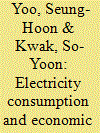

|
|
|
|
|
| Publication |
2010.
|
| Summary/Abstract |
This paper attempts to investigate the causal relationship between electricity consumption and economic growth among seven South American countries, namely Argentina, Brazil, Chile, Columbia, Ecuador, Peru, and Venezuela using widely accepted time-series techniques for the period 1975-2006. The results indicate that the causal nexus between electricity consumption and economic growth varies across countries. There is a unidirectional, short-run causality from electricity consumption to real GDP for Argentina, Brazil, Chile, Columbia, and Ecuador. This means that an increase in electricity consumption directly affects economic growth in those countries. In Venezuela, there is a bidirectional causality between electricity consumption and economic growth. This implies that an increase in electricity consumption directly affects economic growth and that economic growth also stimulates further electricity consumption in that country. However, no causal relationships exist in Peru. The documented evidence from seven South American countries can provide useful information for each government with regard to energy and growth policy.
|
|
|
|
|
|
|
|
|
|
|
|
|
|
|
|
| 6 |
ID:
125684
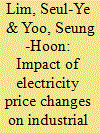

|
|
|
|
|
| Publication |
2013.
|
| Summary/Abstract |
Electricity has played an important role in the economic development of Korea and, thus, has become a critical factor in sustaining the well-being of the Korean people. This study attempts to investigate the impact of electricity price changes on industrial prices and the general price level using input-output (I-O) analysis. To this end, we apply the I-O price model to the 2011 I-O table recently produced by the Bank of Korea, paying particular attention to the electricity sector by considering it as exogenous and then investigating its impacts. The impacts of the electricity price changes on each industrial sector's prices and the general price level are quantitatively derived. For example, the overall impact of a 10% increase in electricity price on the Korean national economy is estimated to be 0.4367%. We also report the results from the model with the electricity sector endogenous and the model with endogenous electricity and labor sectors. This information can be usefully utilized in decision-making regarding price management for electricity.
|
|
|
|
|
|
|
|
|
|
|
|
|
|
|
|
| 7 |
ID:
092731
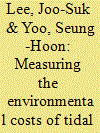

|
|
|
|
|
| Publication |
2009.
|
| Summary/Abstract |
Korea is considering the construction of a tidal power plant (TPP) at Garolim Bay. However, as the construction of the Garolim TPP (GTPP) is expected to entail some environmental damage, it has become an increasingly important topic for public debate. Using a choice experiment (CE) approach, this study attempts to measure the economic cost that results from the environmental damage caused by the construction of GTPP. The CE is used to measure the environmental costs of individual attributes, including the reduction in the area of the tidal flat, the degradation of seawater quality, and the destruction of marine life. The results indicate that the annual willingness to pay (WTP) per household for mitigating the environmental damage that results from the worst-possible situation in relation to the present situation is about 96,042 Korean won (USD 101.1) in the seven biggest cities (off-site regions) and 18,584 Korean won (USD 19.6) in Seosan and Taean (on-site regions). This study is expected to provide policy-makers with quantitative information that will be useful to decide whether or not GTPP should be constructed.
|
|
|
|
|
|
|
|
|
|
|
|
|
|
|
|
| 8 |
ID:
132637


|
|
|
|
|
| Publication |
2014.
|
| Summary/Abstract |
With the increasing importance of natural gas (NG) in the energy mix, the search for a reliable liquefied NG (LNG) supply has received great attention along with energy security in Korea. However, the current level of LNG supply reliability in Korea is much lower than that in other industrialized countries. In order to improve the reliability of the LNG supply, diverse policy measures are required, which come at an additional cost paid by society. This study aims to investigate the public×s willingness to pay (WTP) for improving the reliability of the LNG supply by increasing the LNG storage rate from the current level (11%) to 20%. To this end, the contingent valuation (CV) method is applied by using national survey data of 1000 households. In particular, this study employs a one-and-one-half-bound (OOHB) dichotomous choice model, combined with a spike model, to address the responses from the CV survey with zero WTP. The annual mean WTP is estimated to be KRW 9641 (USD 8.68) per household. Expanding the value to the national population provides a value of KRW 169.43 billion (USD 152.55 million). The results indicate that people are willing to shoulder the burden of safeguarding a reliable supply of LNG.
|
|
|
|
|
|
|
|
|
|
|
|
|
|
|
|
| 9 |
ID:
128383


|
|
|
|
|
| Publication |
2014.
|
| Summary/Abstract |
This paper attempts to examine the electricity demand function in the Korean service sector using the annual data covering the period 1970-2011. The short- and long-run elasticities of electricity demand with respect to price and income are empirically estimated using a co-integration and error-correction model. The short- and long-run price elasticities are estimated to be -0.421 and -1.002, respectively. The short- and long-run income elasticities are computed to be 0.855 and 1.090, respectively. Electricity demand in the service sector is inelastic to changes in both price and income in the short-run, but elastic in the long-run. Therefore, it appears that a pricing policy is more effective than the direct regulation of reducing electricity demand in the long-run in order to stabilize the electricity demand in the service sector. Moreover, it is necessary to encourage a more efficient use of electricity to cope with increasing demand for electricity following economic growth because the electricity demand in the service sector is income-elastic in the long-run.
|
|
|
|
|
|
|
|
|
|
|
|
|
|
|
|
| 10 |
ID:
176691
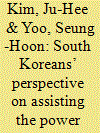

|
|
|
|
|
| Summary/Abstract |
Korea is the only divided country in the world. While power is stably and reliably supplied in South Korea, North Korea (NK) is suffering from a severe power shortage. To improve power supply conditions in NK and ultimately contribute to building peace on the Korean Peninsula, the South Korean Government is considering assisting the construction of power plants and power grids in NK. The Government needs information about households’ willingness to pay (WTP) for assisting the power supply to NK. This article aims to examine the WTP using a contingent valuation based on a nationwide survey of 1000 households. As a WTP elicitation method, the one-and-one-half-bounded question format of asking an interviewee whether she/he has the intention of paying a presented bid through an increase in electricity bills was adopted. The WTP for the assistance was statistically significantly estimated to be KRW 2382 (USD 2.12) per month per household. The estimate of the annual national value amounted to KRW 564.6 billion (USD 503.6 million). This value is by no means small, but it would take a huge amount of effort to elicit public consensus on the assistance considering that a significant proportion of respondents (63.6%) revealed zero WTP.
|
|
|
|
|
|
|
|
|
|
|
|
|
|
|
|
| 11 |
ID:
093550


|
|
|
|
|
| Publication |
2010.
|
| Summary/Abstract |
Air-conditioning and heating energy-saving measures can cut back the usage of energy. This paper attempts to apply a choice experiment in evaluating the consumer's willingness to pay (WTP) for air-conditioning and heating energy-saving measures in Korea's residential buildings. We consider the trade-offs between price and three attributes of energy-saving (window, facade, and ventilation) for selecting a preferred alternative and derive the marginal WTP (MWTP) estimate for each attribute. We also try to test irrelevant alternatives property for the estimation model holds and compare the estimation results of the multinomial logit (MNL) and the nested logit (NL) models. The NL model outperforms the MNL model. The NL model show that MWTPs for increasing the number of glasses and their variety, for increasing the thickness of facade for 1 mm, and for establishing a ventilation system are KRW 17,392 (USD 18.2), 1,112 (1.2), and 11,827 (12.4), respectively. Overall, the potential consumers have significant amount of WTP.
|
|
|
|
|
|
|
|
|
|
|
|
|
|
|
|
| 12 |
ID:
092799


|
|
|
|
|
| Publication |
2009.
|
| Summary/Abstract |
Green electricity is energy that is generated from renewable energy sources such as solar power, wind power, small-scale hydroelectric power, tidal power, and biomass power. These sources mostly do not produce pollutants and are considered environmentally friendly. However, considering the current state of technology, they are more costly. Government should take visible actions to compensate for the increased production costs. This paper attempts to apply a contingent valuation (CV) method to obtain at least a preliminary evaluation of the benefits that ensue from the introduction of the policy that raises the percentage of green electricity consumption from 0.2% of the total electricity supply to 7% by 2011. Overall, the CV survey was successful in eliciting the willingness to pay (WTP) for green electricity considering that the CV method operated within respondents' abilities to answer and the WTP estimates were statistically significant. The monthly mean WTP estimates from parametric and non-parametric methods were KRW 1681 (USD 1.8) and KRW 2072 (USD 2.2), respectively. The estimates of the annual benefits to relevant residents amounted to KRW 150.5 billion (USD 157.5 million) and KRW 185.6 billion (USD 194.2 million), respectively.
|
|
|
|
|
|
|
|
|
|
|
|
|
|
|
|
|
|
|
|
|